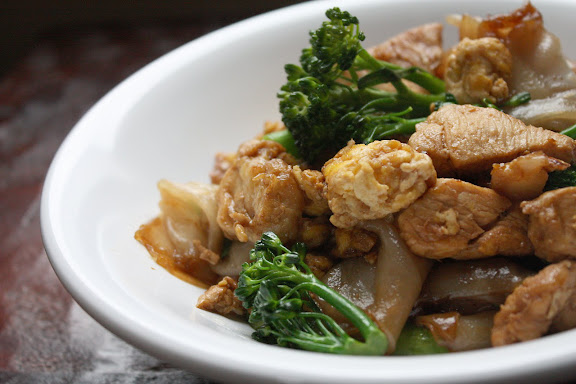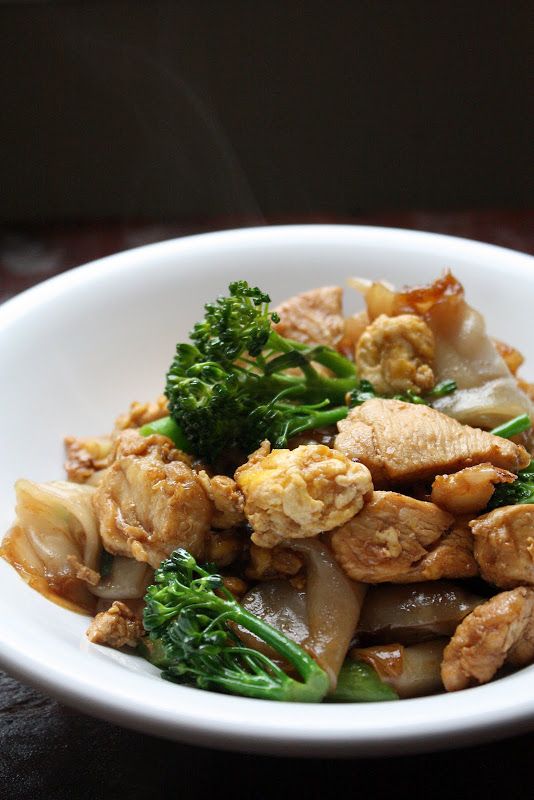To bring you this post, I had to use the little charm I had not only to gain access to the kitchen of a Thai restaurant after they had closed for the night, but also to get them to make a plate of Pad See-Ew* when the people were cleaning up and getting ready to leave.
Did I know no shame? Perhaps not. I did it all for the sake of my readers, you see. Besides, I wanted to make a very important point.
And that point is that unless you’re blessed with a commercial-style range with 17,000 or more BTU burners, your chances of producing the kind of Pad See-Ew (ผัดซีอิ๊ว – literally “soy sauce stir-fry“) they do on the streets of Bangkok or in Thai restaurants overseas are quite slim. If you’ve attempted to make this dish at home and it turned out not exactly like what you had at your favorite Thai restaurant, it’s probably not your fault or the recipe’s; your gas range is a bit wimpy. See how the cook kicked up the heat in the video (below)? If you have an electric range with coil elements, …. (backing away slowly with both hands up).
In the dialogue, the cook is sharing with me the importance of using high — very high — heat in order to get what he calls, “the wok smell.” Chinese cooks know this well: you can’t make good fried noodles or rice without a well-seasoned wok and high heat. If you ever wonder why the fried rice you make at home, though tasty, doesn’t have that familiar toasty fragrance — the secret smell — that you get from restaurant fried rice, what is missing is this “wok smell.” You’ll never get that from using moderate heat. It’s even more difficult, if not virtually impossible, to get that desired fragrance when you use a nonstick pan.
Please don’t shoot me; I’m just the messenger.
Having said that, I wouldn’t want you to be discouraged from giving Pad See-Ew a try at home. What I’m saying is not that homemade Pad See-Ew is unacceptable; I wanted to make sure you know that if the fried rice or fried noodles you make at home, even under the guidance of the best of recipes, don’t turn out the same as what you get from the restaurant, it’s not necessarily your fault. And though you can’t exactly replicate the restaurant dishes, you can still produce delicious fried rice and noodles.
Besides, there’s a way to get around that, and that is to use the highest heat setting your range allows when you make Pad See-Ew and not be afraid to let things brown up at the bottom of the pan. If you can’t get the so-called “wok smell” like they do in the restaurants, at least try to get that “nutty,” toasty caramelized bits at the bottom of the pan or wok that would add tons of flavor to your fried noodle/rice dish and a bit of “restaurant” flavor — the secret smell — to your homemade creations.
Important: You should never make more than 2 servings at a time. The bigger the batch, the soggier your noodles become. The soggier your noodles, the more likely they will fall apart. Respectable Thai street food vendors make this on demand and never more than 2 servings at a time.
*The standard transliteration is Phat Si-io. But it’s more popularly spelled Pad See Ewe, Pad Si Ewe, Pad See Ew, Pad See-iw, Pad See-Euw, etc. To pronounce this the way literate native Thais do, make sure you pronounce the first syllable “putt” (as in “Let me show you how to sink more putts and reduce your golf handicap”). The second syllable is pronounced exactly like “see,” and the last syllable rhymes with “cue.”
- ⅓ cup plain vegetable oil
- 8 ounces of fresh, flat and wide rice noodles (not dried)
- One large egg
- 2 tablespoons of sweet dark soy sauce.
- Mixture of 2 tablespoons oyster sauce, 2 teaspoons light (or "white") soy sauce, 2 teaspoons sugar, 2 teaspoons white vinegar, and 1 medium clove of garlic (peeled and minced)
- 4 ounces sliced meat of choice, marinated in 2 teaspoons light soy sauce and a teaspoon of baking soda
- One and one half cups of Kai-Lan (Chinese broccoli) or, if you really can't find it, broccoli florets, loosely packed
- Follow the steps in the video. Add the partially-cooked meat to the pan at the same time as you do the vegetable.










140 Responses to Pad See-Ew (ผัดซีอิ๊ว)